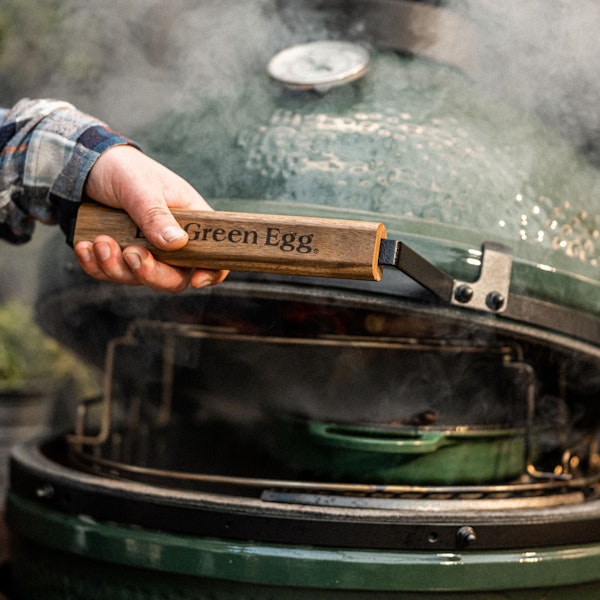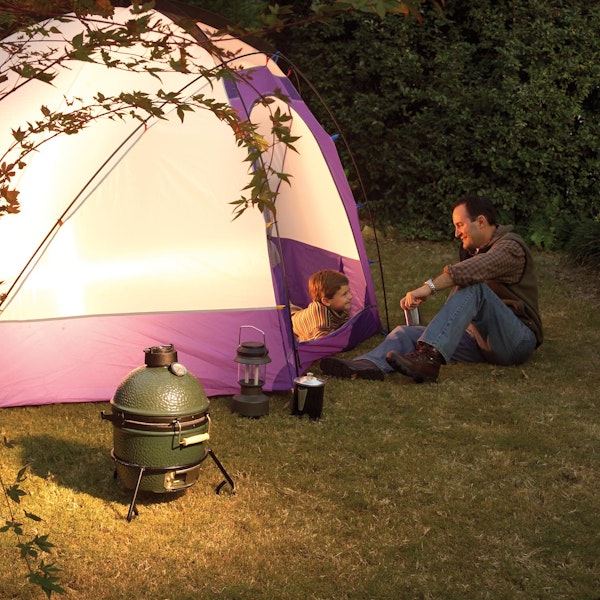
50 Years of the Big Green Egg with Ed Fisher
Main content
Over the past 50 years
Big Green Egg has become a brand loved and admired around the world. This is something Ed Fisher, founder of the Big Green Egg, never dreamed of in the 1970s when he introduced the kamado to the Western world and perfected the details of this cooking marvel. Discover the extraordinary history of The Evergreen here.
The Background
Although the UK was only introduced to the Big Green Egg at the beginning of the 21st century, its history goes back much farther. Its distant predecessor was the wood-fired tandoor, a ceramic clay pot without a lid. The tandoor was already being used some 5,000 years ago as type of oven for baking bread and cooking meat. This early Asian kamado is related to the later mushi-kamado, a rice steamer that was given a lid over 100 years ago. Among other things, this allowed heat to be retained and the fire to be controlled, making this mushi-kamado an exceptional cooking appliance. The real story of the Big Green Egg, however, begins 50 years ago in 1974 when the US was introduced to this Asian kamado thanks to Ed Fisher.

Pachinko House
Ed Fisher travelled to Japan once he left the Navy, and saw these kamado cookers in the land of the rising sun. Once back in the US he became acquainted with other servicemen who had brought one or two back for themselves to cook with, and he began to explore doing the same with the intention to resell them. Soon, in 1974, he opened a small shop called Pachinko House on Clairmont Road in Atlanta. Ed: “My core business was importing and selling Japanese pachinko machines, a popular arcade game at the time. But besides that, I had imported 20 or 30 kamados. The pachinko machines were a seasonal product, so I aimed to cover the quiet months with the sale of kamados.”
Tasty and juicy
“The kamado, which means oven or stove, was virtually unknown in the US at that time,” Ed continues. “The American barbecue scene used kettle barbecues. Only a few of the soldiers who had been stationed in Japan had taken this type of cooking device home with them. They fitted the kamado with a grill and used it as a smoker and barbecue. I remember when I first cooked on a kamado and tasted the results – it was amazingly juicy and delicious! At first I thought I might be imagining it because I was hungry, but it tasted just as good every single time.”

Ed's chicken wings
To pique the curiosity of customers and passers-by and introduce them to the tasty and succulent result, Ed Fisher placed a kamado in front of his shop. He prepared chicken wings on it and the subsequent commotion and delicious smells attracted attention. Ed: “I chose chicken wings because I was low on budget and they were not that expensive. Passers-by didn’t know what they were tasting. I remember that I had only just opened the store and someone tasted a chicken wing; half an hour later, I sold my first kamado. At that moment I thought, ‘Wow, I could be onto something here.’ But I never thought the concept would develop to become so huge.”
Advantages of a kamado
From then on, people began to realise what a special cooking device the kamado was based on their own experiences, and its popularity grew rapidly, mostly through wordof-mouth. “People discovered the benefits of a kamado,” Ed continues. “Besides the tasty result, it also consumed less fuel than a kettle barbecue. The customers who bought one cooked for family and friends, who then shared their excitement. After a few years, sales of the pachinko machines declined, as electronic video games took off, and my focus shifted full time to selling and developing kamados.” At this time, they were still sourced in Japan and painted in different colours, but soon Ed made the fateful decision that they would all be green, and that he would call his product not a kamado but a Big Green Egg, because that is what he saw when he looked at one!

The best in the world
As popularity grew, the company responded to the need for additional models and the Mini, Small and Medium models were introduced. Ed continuously refined the kamados, based on feedback from his customers and his own experiences. Modifications included the cookers being fitted with a dome thermometer and that natural lump charcoal, rather than briquettes, was recommended as the fuel. The natural charcoal gives better temperature control and prevents the unwanted flavours that briquettes sometimes cause. Ed: “My cooking skills also improved and I became dissatisfied with the quality and thermal properties of the clay-made kamados from Asia. They were fragile, resulting in frequent breakage during transport and rapid temperature changes during use. The ceramic element had to be stronger, more durable and lighter, but also have better heat-insulating properties. I wanted to make the best kamado in the world.”
The ultimate ceramic
The search for the ultimate ceramic then followed. At the Georgia Institute of Technology (Georgia Tech), research into lightweight ceramics had been going on since the 1960s. Its main objective was the assembly of ceramics that could withstand extreme heat, among other things for NASA's space activities. The heat-resistant ceramic tiles of the space shuttles were exposed to extremely high temperatures during the flight. Ed: “One of my friends was working at the facility where these ceramics were developed. He advised me on how to choose the ultimate ceramic for the Big Green Egg and recommended a high-tech factory in Mexico where the ceramic parts could be made. In the mid-1990s, we stopped importing kamados from Asia and began to produce the Big Green Egg ourselves. The EGGs were also coated with a solid porcelain enamel. From that moment on, all ceramic parts of the Big Green Egg were made in North America, and today all the components of the entire EGG are sourced from within the Americas.”

Strong and durable
“The Big Green Egg is the only kamado produced to this standard of quality with the raw materials that we use, unlike most kamados that still come from Asia,” Ed continues. “Ordinary ceramics are less solid, less durable, and much less heat-insulating than the NASA-developed ceramic from which the Big Green Egg is made. The ceramic of the Big Green Egg consists of a unique and carefully balanced fi ne clay composition. This gives the ceramic a fine structure and makes it strong and durable. Thanks to the amazing insulating properties of the ceramic, the Big Green Egg uses charcoal economically and the temperature is very stable. Fine ceramics also absorb less moisture from ingredients than kamados with coarser ceramics. That means food keeps its flavour and doesn't dry out. Another important point is that when heated, ceramics expand and then shrink again when cooled. Thanks to the superior structure of Big Green Egg ceramic, this happens more evenly so the risk of cracking is minimal.”

Innovations
Meanwhile, developments progressed steadily, resulting in several innovations. Perhaps the most revolutionary launch after the introduction of ceramics was that of the convEGGtor, initially called a Plate Setter. This made the EGG much more versatile as it enabled an EGG to work like a giant convection oven and led to even more cooking techniques. The integrated Nest+Handler, which made moving the EGG much simpler, and the improved hinge system, to open and close the Big Green Egg even more easily, were other great improvements and additions. Next came the rEGGulator, enabling even more precise temperature control, the EGGspander and numerous other accessories. Also, the use of steel bands around the ceramic base and dome was a deliberate choice to perfect the EGGs. The reason for this is that metal, unlike stainless steel, shrinks and expands with the ceramic when heated. In addition, three more models have been added to the family in recent years: the XLarge, 2XL and the popular MiniMax.

To the next 50 years
“The number of fans is still growing and we are hugely proud of that fact. The Big Green Egg is the result of 50 years of a solid foundation, plus innovation, research and development, where every detail has been extensively examined and tested. Over the years, we have developed a unique cooking appliance and achieved the goal of producing the best kamado in the world. We are still investing in ongoing improvements so that Big Green Egg remains the best kamado-style cooker worldwide. It’s safe to say that the Big Green Egg has often been imitated but never equalled,” Ed concludes, “and we intend for it to stay that way for another 50 years to come!”.
Join the Club for free, to be a part of the next 50 years.
